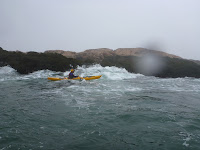I paddled beside Rebecca as the western sky took-on a rosy, decidedly evening feel. “Well,” I said. If we don’t want to get into camp late, we could always stop somewhere else. Steves Island, maybe. We’d get a nice sunset on Harbor. Or Kimball- we’d be most of the way there.”
“That could be okay,” she said, but didn’t break stride. Isle au Haut rose as a backdrop, still mostly obscured by other islands, and we kept paddling as if to get those islands out of the way.
“Of course,” I added, “we’d have the current against us in the morning.”
“And fog. It’s supposed to turn foggy and rainy. I’d rather get there.”
This last minute, tardy departure felt too usual for us. We were always running late, getting things done at the last minute. We were lucky to have even launched on Monday. The tasks were never finished, and the longer we stuck around, the more the phone rang and the emails came: it seemed irresponsible to be leaving at all. That afternoon, I’d walked into the back of the darkened gallery just as a man on the sidewalk tried the locked door and saw me. To be polite, I opened the door to tell him we’d be closed for a few days, but he didn’t care about that. “Is there a restaurant around here,” he asked, “that serves lobster?” A joke? No- a frequently-asked question. He looked over my shoulder and followed it up with another: “Are you one of the artists?” We launched by quarter to five.
The wind picked-up against us and developed a mild chop. We still had the current with us. At Steves we kept right on going. At Harbor, we paused. The idea was enticing, but we wanted to get there tonight. We wanted to wake up in the morning and have all day. Three all days actually- and another half day on Friday, when we would need to return to Stonington and open the gallery. After which, the gallery would be open every day for the next four and a half months- with at least one of us there every day. It was good we were taking a break.
The current had turned against us by the time we entered the Isle au Haut Thorofare, tilting the buoys toward us. Along shore we found an eddy and passed town: no one was about- just a well-preserved car from the 1960s rumbling slowly past. The lighthouse beckoned. We arrived at Duck Harbor just in time to get settled-in before dark.
Duck Harbor Campground has only five sites, all Adirondack-style lean-tos- posh camping on the southern end of Isle au Haut, Acadia National Park’s remote section. Until June 15th when the tour boats start running there, the only likely way to get there is under your own steam. You could take the mailboat into town and backpack or bicycle the rest of the way, or get there in your own boat. I’d made reservations back in early April, which not only held our site, but ensured that we would take the time off for the trip. Two other couples camped quietly nearby.
We spent the next three days walking around on the trails and the rocky shoreline, staring at rocks, mesmerized by waves. Fog and rain came and went and came back again. It was springtime and the plants were just getting started, bright leafy green everywhere, birdsongs a constant backdrop.
The trails were often squishy and damp, but they led to amazing places. We took our time. Rebecca painted. Sometimes I opened a book, or if Rebecca became busy with a painting, I took off bushwacking up to rocky promontories, trying to fill in the gaps of shoreline that the trails left-out.
We both did a lot of staring at waves and rocks. What went through our minds while we stared? Rebecca, I’m assuming, was often going through that process of creating art. How do I paint that? What makes it interesting? Will anyone else see how cool this looks to me? I often found myself following an imaginary kayak in through rocky gaps, tracing its course as it negotiated a turn, got stuck on a rock, and inevitably- pounded by one of the bigger waves that always seemed to follow. Good practice. Maybe better if I’d followed it up with actual paddling... but maybe just as well that I didn’t.
The days passed. On Friday morning we headed back in the fog. We were in less of a hurry to get back to Stonington. The fog lifted enough here and there to make it more atmospheric than hazardous- a gentle way to return and plunge into our summer.




































































